
Are Caterpillars Pests or Pollinators? You Might Be Surprised
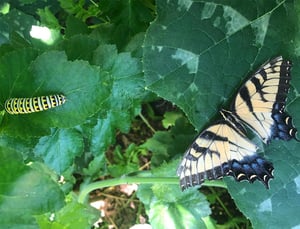
Hi everyone, it’s Brie the Plant Lady checking in with an important blog specifically about caterpillars in the garden!
As gardeners, we often hear conflicting advice about managing caterpillars, and it can be challenging to navigate what’s best for our plants and the environment. That’s why in this article I am diving into the fascinating world of “pests” and “pollinators.” Spoiler alert: it’s not as straightforward as it might seem!
Pollinator insects like bees and butterflies are essential for a thriving garden. Did you know that other insects such as moths, ants, flies, wasps and even some beetles fall into the pollinator category too? They all play a critical role in plant reproduction, helping fruits, vegetables, and flowers flourish.
Caterpillars are the larval form of butterflies and moths. However, not all caterpillars in the garden are helpful. Pests like cutworms, hornworms, and cabbage worms (all really caterpillars, not worms!) can wreak havoc on plants by feeding on foliage, stems, and fruits.
The tricky part? Some caterpillars can straddle both categories. While they might feast on your plants now, many will transform into pollinators later.
In this blog, I’ll share tips for managing caterpillars specifically. I'll provide solutions for organic control, tips on how to support pollinators, and my advice on how to strike a balance that promotes a healthy, vibrant garden. Let’s dig in and tackle the caterpillars in your landscape together!
Caterpillar - Pest or Pollinator?
One of my favorite aspects of gardening is seeing butterflies fluttering around all summer long. Over the years, I’ve focused on creating habitats and growing plants that benefit all stages of their lifecycle. Naturally, I’m delighted when I spot swallowtail caterpillars happily munching on my carrots, cilantro, dill, fennel, parsley, and other plants in the Apiaceae family. I planted these specifically to support them!
The same enthusiasm extends to the endangered Monarch butterflies, whose caterpillars rely solely on milkweed plants to eat. In recent years, I planted hundreds of milkweed plants in my garden with the sole purpose of feeding these monarch caterpillars. Watching them thrive is an incredible reward. Be sure to plant the appropriate native species for your region which include Asclepias incarnata (swamp milkweed), Asclepias tuberosa (butterfly weed), and Asclepias verticillata (whorled milkweed).
Hummingbird moths are a great example of a wonderful pollinator in adult form that feed on native fragrant, tubular flowers like phlox, honeysuckle, and bee balm. Their long proboscis allows them to access nectar deep within blooms, aiding in pollination as they dart from flower to flower. With their rapid wing beats and hovering flight patterns, they’re easily mistaken for hummingbirds, but these day-flying moths belong to the Sphingidae family. Their ability to pollinate flowers makes them valuable allies for gardeners seeking to support pollinator populations. They are fascinating to watch in the garden, especially in slow motion video!
However, their larval stage, which is also commonly known as “hornworms,” can create some confusion. While tomato and tobacco hornworms (also in the Sphingidae family) are infamous for devouring crops, not all hornworms are pests. Many hornworm species feed on native plants, contributing to the ecosystem without causing harm to your garden. The key here is to properly identify who is eating what because not all hornworms are bad!
Of course, not all caterpillars earn such a warm welcome. Unlike the habitat I aim to create for swallowtails, monarchs, and hummingbird moths, I do not plant broccoli and cauliflower to feed cabbage worms. These voracious pests can devastate my brassicas in no time, leaving me torn between nurturing desirable caterpillars and managing those I wish to eradicate.
Balancing the needs of beneficial butterflies while keeping destructive pests at bay is one of the most challenging aspects of gardening. It forces me to approach each situation differently, valuing some species while carefully managing others.
- Role in Ecosystem: Does the caterpillar become a butterfly or moth that benefits pollination?
- Host Plant: Is it feeding on ornamental or native plants you’ve grown to support wildlife, or is it damaging crops meant for your table?
- Population Size: Are they causing significant damage, or are their numbers manageable?
- Long-Term Impact: Will the feeding cause irreversible harm, or is it a temporary inconvenience?
By identifying these caterpillars and understanding their roles, you can take a balanced approach, nurturing pollinators while effectively managing pests.
Know Who You Are Looking At
Before you get too anxious about insects in your garden it is critical to properly identify what the insects are.
As I mentioned above, many insects go through several life stages, particularly caterpillars, so they could be a pest in their larval (caterpillar) form, yet become a pollinator as an adult butterfly or moth. Recognizing what insects are causing damage, and then coming up with a safe strategy for management is critical.
What are the best resources for insect identification?
- Google Lens phone app has become reliable at insect identification. Be sure to cross check the identification results in books or by searching the Internet.
- For more localized assistance, each state's Cooperative Extension service can connect you with county agents and specialists who provide guidance on insect-related concerns in your area.
Most Common Caterpillars in Your Garden
Here’s a list of the most common or notorious caterpillars that might visit your garden in the southeastern U.S., along with tips for deciding whether they are pests to manage or future pollinators to support. This diversity highlights the complexity of gardening in harmony with nature while meeting your needs.
POLLINATOR: Swallowtail Caterpillars
Species: Black swallowtail (Papilio polyxenes), eastern tiger swallowtail (Papilio glaucus), spicebush swallowtail (Papilio troilus)
Host Plants: Black and eastern tiger swallowtails feed on plants in the Apiaceae (carrot) family (carrots, dill, parsley, fennel) and spicebush, sassafras; spicebush swallowtails feed on plants in the Lauraceae (laurel) family
Role: Pollinator butterfly
Action: Encourage and plant plenty of host plants and tolerate their feeding. They will reward you with beautiful butterflies
POLLINATOR: Monarch Caterpillars
Species: Danaus plexippus
Host Plants: Milkweed (Asclepias spp.)
Role: Pollinator butterfly (threatened species)
Action: Support and grow milkweed and avoid pesticides near these plants
Comparison photos of similar caterpillars of two pollinator butterflies.

POLLINATOR: Gulf Fritillary Caterpillars
Species: Agraulis vanillae
Host Plants: Passionflower vines (Passiflora spp.)
Role: Pollinator butterfly
Action: Protect and grow passionflowers to support these striking orange butterflies
Gulf fritillary caterpillar on a passionflower vine leaf. Photo by Hillary Thompson.

POLLINATOR: Zebra Longwing Caterpillars
Species: Heliconius charithonia
Host Plants: Passionflower (Passiflora spp.)
Role: Pollinator butterfly (Florida’s state butterfly)
Action: Encourage as these caterpillars are valuable pollinators in their adult form
Photo: Identification pictures can be found here: https://bugguide.net/node/view/533
POLLINATOR: Hummingbird Clearwing Moth
Species: Hemaris thysbe; the caterpillar is a type of hornworm and easily mistaken for tomato or tobacco hornworms
Host Plants: Honeysuckle, Viburnum, Cherry
Role: Pollinator moth
Action: Encourage and grow more native plants as they are valuable pollinators in their adult form
Photo: Identification pictures can be found here: https://bugguide.net/node/view/2638
PEST: Cabbage Worms
Species: Imported cabbage worm (Pieris rapae), larvae of the small white butterfly
Host Plants: Brassicas (broccoli, cauliflower, Brussels sprouts, cabbage, kale)
Role: Voracious pest of food crops (damages crops)
Action: Manage by using row covers, handpick, and apply Bt sprays and dust to kill the caterpillars.
Cabbage worms eat leaves of plants in the Brassica family.

PEST: Squash Stem Borer
Species: Melittia cucurbitae
Host Plants: Squash vines, including pumpkins (sometimes cucumbers and melons)
Role: This pest caterpillar bores into the stem, eventually killing squash vines
Action: Prevent by using stem barriers and applying Bt sprays and dust
Photo: Identification pictures can be found here: https://www.insectimages.org/search/action.cfm?q=Melittia+cucurbitae
PEST: Pickle Worms
Species: Diaphania nitidalis
Host Plants: Squash, pumpkins, and cucumbers (sometimes melons)
Role: This pest caterpillar bores into the fruits; they are native in the subtropics and spread northwards in the summer and late summer; sometimes damage is only superficial and the produce is fine to eat (however, it disfigures the produce so it cannot be sold)
Action: Plant earlier in the year; monitor and apply Bt or diatomaceous earth to prevent and manage outbreaks
Photo: Identification picture can be found here: https://www.insectimages.org/browse/detail.cfm?imgnum=1327043
PEST: Tomato & Tobacco Hornworms
Species: Manduca quinquemaculata & Manduca sexta
(larvae of hawk moths)
Host Plants: Tomatoes, peppers, eggplants, tobacco; all plants in the nightshade family, including weeds in the nightshade family
Role: Both hornworms are voracious caterpillars that quickly eats leaves, stems, and entire branches of nightshade plants
Action: Inspect plants daily and control by hand removing; usually populations are small enough that hand removal is adequate; encourage parasitic wasps that lay eggs in hornworms
White eggs from the parasitic wasp on a tobacco hornworm.

PEST: Fall Armyworms
Species: Spodoptera frugiperda
Host Plants: Corn, Bermuda hayfields and other grasses (including lawns), tomatoes, and other crops
Role: This voracious pest quickly eats crops and lawns; they are native in the subtropics and spread northwards in the summer and late summer
Action: Monitor and apply Bt or neem oil to manage outbreaks

PEST: Eastern Tent Caterpillars
Species: Malacosoma americanum
Host Plants: Cherry, apple, crabapple, persimmon
Role: Mixed, as they can defoliate trees but rarely cause long-term damage
Action: Prune and remove tents early and encourage natural predators like birds, mammals, reptiles, and other insects. Develop some tolerance for the "tents" as the caterpillars can be an important food source for wildlife.
Eastern tent caterpillar - Photo by Hillary Thompson.

PEST: Spongy or Gypsy Moth Caterpillars
Species: Lymantria dispar
Plants Attacked: Deciduous trees (oak, maple, birch)
Role: This pest is an invasive species causing significant damage to trees
Action: Manage by adding sticky traps, encourage natural predators, and apply Bt to limit their impact
Spongy moth caterpillar photo from the USDA website.

PEST: Saddleback Caterpillars
Species: Acaria stimulea
Host Plant: Many trees and shrubs, but the damage is rarely significant to plants
Role: Native caterpillar that causes an intense and painful stinging from their venomous spines; monitor yourself for possible medical issues if stung, such as migraines, nausea, and anaphylactic shock
Action: Encourage natural predators; apply Bt and neem oil to limit their impact in areas you frequently garden
Close of up of the venomous spines on the saddleback caterpillar.

I will never forget my first encounter with a saddleback caterpillar. The pain was so intense, I genuinely thought I had been electrocuted while weeding in a bed full of waist-high plants. Having grown up in the Midwest, I had never heard of this caterpillar, nor had I ever experienced something so excruciating.
At first, I couldn’t figure out what had caused the sudden burning sensation on my arms, hands, and legs. I scoured the plants for over an hour, determined to find the culprit. Finally, I spotted a group of small, vividly green caterpillars with a brown “saddle” on their backs and spiny horns at either end. The sight was unforgettable, a creature both beautiful and intimidating.
From that moment on, I’ve walked with caution in the garden, keeping an eye out for saddlebacks and always wearing gloves! They’ve become a vivid reminder of the hidden surprises a garden can offer, both painful and fascinating!
Organic Methods to Deter Caterpillars
The "pest" caterpillars I described above can wreak havoc in your garden.
Fortunately, there are effective organic methods to protect your plants. Here are some strategies to deter these common pests:
Physical Barriers: Install collars around young plants to prevent cutworms from accessing stems. Floating row covers can shield crops from moths that lay eggs, reducing caterpillar infestations.
Handpicking: Regularly inspect your plants and manually remove caterpillars. Early detection prevents major damage and keeps populations under control.
Beneficial Insects: Encourage natural predators like ladybugs, lacewings, and parasitic wasps by planting pollinator-friendly flowers. These insects help reduce caterpillar numbers naturally.
Companion Planting: Use companion plants like marigolds, dill, and basil to repel moths and caterpillars. Their strong scents deter pests while enhancing your garden’s diversity.
Diatomaceous Earth: Sprinkle food-grade diatomaceous earth around plant bases. This natural powder is abrasive to caterpillars and other soft-bodied insects, discouraging them from climbing plants.
Neem Oil: Apply neem oil as a foliar spray to disrupt caterpillars’ feeding and growth cycles. Neem oil is an organic, plant-based insecticide that is safe for beneficial insects when used appropriately.
Crop Rotation: Rotate crops annually to disrupt the life cycle of pests that overwinter in soil.
Bacillus thuringiensis (Bt): Use Bt, a natural bacterium, as a targeted spray against caterpillars. It is harmless to humans, pets, and beneficial insects but effective against caterpillars.
Integrated Pest Management (IPM) Strategies: Striking a balance between pollinators and pests involves integrated pest management strategies. IPM techniques such as these will help control pests while preserving pollinators:
- Introducing or planting to attract natural predators
- Companion planting
- Rotating crops
- Focusing on diversity
By combining the techniques techniques I just described, you can protect your garden from caterpillar damage without relying on chemical pesticides. With a proactive approach, you’ll create a thriving, balanced ecosystem that supports healthy plants and beneficial wildlife.
Though I aim to implement all these best practices, Bt remains my go-to method for managing problem caterpillars. I specifically target Brassica family plants that are prone to infestations, such as broccoli, Brussels sprouts, cabbage, cauliflower, and kale. Over the years, I’ve developed a routine that focuses on prevention. I pre-spray any vegetable plants I purchase before planting and, when growing these crops from seed, I dust the seed trays with powdered Bt before germination. Once the seedlings are planted, I apply liquid Bt every 10–14 days to maintain protection and prevent any caterpillar populations from starting.
I also rely on neem oil as a secondary line of defense. I always keep a bottle handy for quick and easy applications. Its versatility as an organic pest control method makes it invaluable for managing not only caterpillars but also other garden pests year-round, ensuring my crops remain healthy and productive.
In my nearly 30 years of growing vegetables, my best advice is this: prevention is key.
Tackling potential pest problems before they escalate will save you time, effort, and heartbreak. Remember, not all caterpillars are created equal and knowing which ones to welcome and which to control is key to a successful garden. With these tips, you’re equipped to strike the right balance between nurturing pollinators and protecting your plants. So, grab your garden gloves, observe closely, and embrace the dynamic world of caterpillars—both the good and the bad!
For information on how to control other insects in your garden read: Organic Insect Control for Every Garden
Brie the Plant Lady
All photos by Brie Arthur, unless noted.
Related Posts

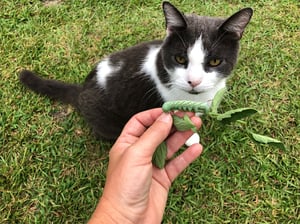
Organic Insect Control for Every Garden
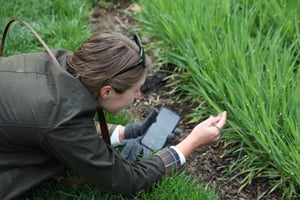
I Love the Family Poaceae - The Grass Family
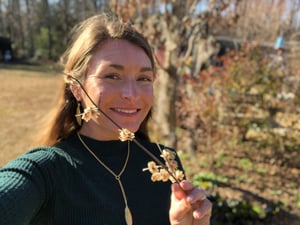
Brie's Plant Pick: Wintersweet

Brie's Gardening Ideas for August

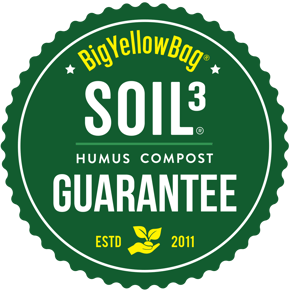
Did this help you out? Have any questions for clarity? Leave a comment below!